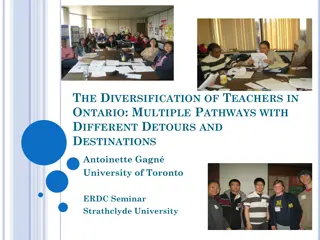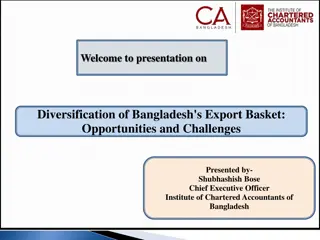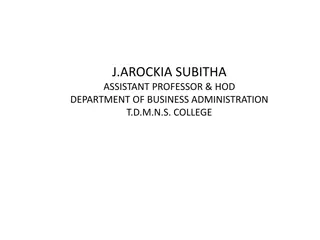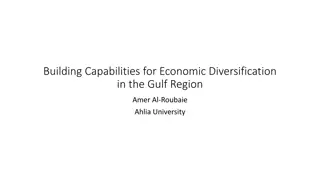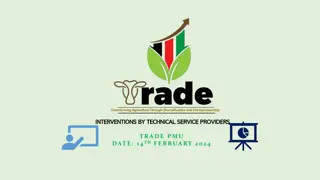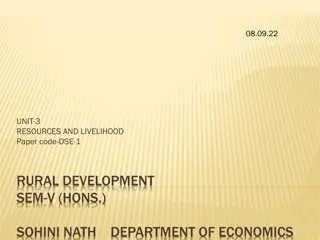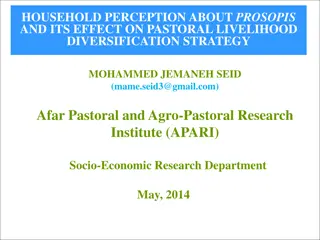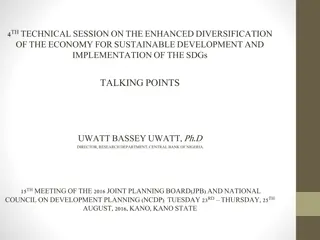Economic Diversification in Marathwada Region
Economic diversification, particularly in agriculture, is examined in the Marathwada region of Maharashtra, focusing on cropping pattern changes, growth rates of major crops, extent of crop diversification, and determinants over a 30-year period. The study delves into selected crops, data sources, methodology, and objectives to understand the structural transformation of the economy.
Download Presentation

Please find below an Image/Link to download the presentation.
The content on the website is provided AS IS for your information and personal use only. It may not be sold, licensed, or shared on other websites without obtaining consent from the author.If you encounter any issues during the download, it is possible that the publisher has removed the file from their server.
You are allowed to download the files provided on this website for personal or commercial use, subject to the condition that they are used lawfully. All files are the property of their respective owners.
The content on the website is provided AS IS for your information and personal use only. It may not be sold, licensed, or shared on other websites without obtaining consent from the author.
E N D
Presentation Transcript
INTRODUCTION Diversification is an integral part of the process of structural transformation of an economy, diversification in agriculture can mean any of the three situations : (1) A shift from less profitable crop (or enterprise) to more profitable crop (or enterprise) (2) Using resources in diverse but complementary activities (Vyas,1996). The first type can be viewed as a farmers response to relative price signals to adjust to the market conditions and The second type hints towards efficient allocation of resources.
Objectives 1) To examine cropping pattern changes in different districts of Marathwada region over a period of time 2) To study growth rates of area , production and productivity of major crops in different districts of Marathwada region 3) To study extent of crop diversification in different districts of Marathwada region 4) To identify determinants of crop diversification in different decadal periods.
METHODOLOGY The study was confirmed to the Marathwada region of Maharashtra state. Therefore, the analysis for the present study was extended to two divisions of Marathwada i.e. Aurangabad and Latur and for Marathwada region as a whole. The districts selected for the present study were Aurangabad, Jalana , Beed , Latur , Osmanabad , Nanded , Parbhani , and Hingoli. For the present study all the major food grain and non food grain crops of Marathwada region were selected.
Crops selected for the study 1) Cereals group - 1.Rice 3.Jowar - 4.Bajara 5. Maize 6.Other cereals 2. Wheat Kharif and Rabi jowar 2) Pulses group - 1.Tur 3.Mung 2.Gram 4.Other pulses 3) Oilseed groups - 1. Groundnut- Kharif and Summer groundnut 2. Soybean 3.Safflower 4. Sunflower 4) Commercial crops - 1. Cotton 2.Sugarcane
Data base The present study (secondary) data on the area, production and productivity of selected crops , total food production , crop-wise area under irrigation, season- wise crops grown , area under high yielding varieties of different crops, net cultivated area , area sown more than once, gross cropped area, annual rainfall, year-wise fertilizer consumption, source wise irrigation , average size of holding, and other infrastructural facilities like number of regulated markets ,no of tractors , agricultural advances, road length, number of working population , proportion of rural population , per capita income , state GDP and state income etc have been collected for the period 1980-81 to 2009-10. The data has pertained to a period of 30 years i.e. from 1980-81 to 2009-10, 2009- 10 is the terminal period of the study as consolidated data was available upto 2009-10 only. was based on secondary data. Time series
Analysis of cropping pattern changes Cropping pattern of various districts and divisions of Marathwada as well as Marathwada region as a whole have been studied in detail by tabular analysis for all the selected crops. Cropping pattern in terms of percentage share of individual crops in gross cropped area was worked out at points of time. The points at which analysis of cropping pattern has been worked out for the period i.e Period I 1980-81 to 1984-85 , Period II 1985-86 to 1989-90 , Period III 1990-91 to 1994-95, Period IV- 1995-96 to 1999-2000 , Period V 2000-01 to 2004-05, Period VI -2005-06 to 2009-2010 and for Overall Period- 1980-81 to 2009-2010.
Growth analysis compound growth rates . It was estimated with the following exponential model. Y = a b x e u Log Y = log a + x log b + u CDI = Antilog of ( b -1) x 100 Where, Y = The dependent variable (area/production/yield) a & b = Parameters of exponential model
Quantification of crop diversification Crop diversification index and cropping intensity are indicators for observing and quantifying cropping pattern changes. Entropy index (EI) The index has been computed by taking the sum of squares of area proportion of each crop in the total cropped area. It has been calculated as: Entropy index = Pi log (1/Pi) i = 1 N Where, N = Total number of crops Pi = Proportion of area under ith crops to total cropped area. approaches zero when there is perfect concentration ,i.e., when Pi equals one the upper bound of index is log N. The index would increase with the increase in diversification and it
Cont.. Modified Entropy Index (M.E.I.) Modified Entropy Index is used to overcome the limitation of Entropy Index by using variable base of logarithm instead of fixed base of logarithm .It can be computed as : N M.E.I= - (Pi.log N P it ) i=1 The M.E.I, however ,is equal to EI/ logN. It is worth mentioning that the base of logarithm is shifted to N number of crops. This index has a lower limit equal to zero when there is complete concentration , and it assumes upper limit of one in case of perfect dispersion , i.e. it is bounded by zero and one .
Cont Composite Entropy Index ( C.E.I) This index possesses all desirable properties of Modified Entropy index, and was used to compare diversification across situations having different and large number of activities since it gives due weight to the number of activities . The formula of calculating C.E.I is given by : N C.E.I = - ( Pi x log N Pi )*{1- (1/N)} Or i = 1 C.E.I=(Modified Entropy Index)*{1-(1/N)} The C.E.I has two components , distribution and number of crops, or diversity .The value of composite Entropy Index increases with the decrease in concentration and rises with the number of crops/activities . Both the components of index are bounded by zero and one and thus the value of C.E.I ranges between zero and one.
Factors affecting on crop diversification Y = a + b1 X1 + b2 X2 + + b n X n + U The explanatory variables will be considered as : X1 = Per capita income (Rs / person), X2 = Percentage of urban population, X3 = Percentage of area under high yielding variety (HYV) of cereals, X4 = Percentage of gross irrigated area to gross cultivated area, X5 = Annual rainfall (mm), X6 = Average size of land holding (ha) , X7 = Market density (number of markets per 1,000 ha of gross cropped area), X8 = Fertilizer use (Kg/ha), X9 = Road length ( square km per 1,000 ha of gross cropped area ), X10 = Percentage of small and marginal land holders in total holdings, X11 = Mechanization (number of tractors per 1,000 ha of gross cropped area ), and U = Error term.
Table 1 . Change in cropping pattern in Marathwada region during 1980-81 to 2010-11 ( Area in 00 hectares ) Marathwada Region Period I % Period II % Period III % Period IV % Period V % Period VI % overall % Rice 1093 2.19 1036 1.89 1044 1.88 930 1.59 866 1.39 458 0.67 905 1.55 Kh.jawar 10228 20.47 9987 18.23 9584 17.22 8107 13.84 7052 11.31 5321 7.77 8380 14.37 R.jawar 10541 21.09 10961 20.00 10048 18.06 10153 17.34 10997 17.64 10758 15.71 10576 18.14 Bajara 3500 7.00 4212 7.69 4665 8.38 4575 7.81 4430 7.11 3658 5.34 4173 7.16 wheat 2874 5.75 2033 3.71 1976 3.55 2576 4.40 2413 3.87 3035 4.43 2485 4.26 Maize _ _ _ _ _ _ 625 1.07 1639 2.63 2086 3.05 725 1.24 Oth.cereals 480 0.96 531 0.97 773 1.39 1014 1.73 1776 2.85 2398 3.50 1162 1.99 Tur 2820 5.64 3379 6.17 4043 7.27 4096 7.00 4197 6.73 4429 6.47 3827 6.56 Gram 1766 3.53 1868 3.41 1857 3.34 2331 3.98 2644 4.24 3785 5.53 2375 4.07 Mung _ _ _ _ _ _ 1413 2.41 2651 4.25 1891 2.76 992 1.70 oth.pulses 4680 9.36 5741 10.48 5356 9.63 5070 8.66 5771 9.26 4882 7.13 5250 9.00 Kh.gn 1016 2.03 974 1.78 848 1.52 624 1.07 432 0.69 311 0.45 701 1.20 Summ Gn 201 0.40 563 1.03 523 0.94 273 0.47 194 0.31 238 0.35 332 0.57 Safflower 2724 5.45 3330 6.08 2576 4.63 2127 3.63 1932 3.10 1783 2.60 2412 4.14 Soybean _ _ 12 0.02 123 0.22 268 0.46 2462 3.95 6965 10.17 1638 2.81 Sunflower 860 1.72 2595 4.74 3493 6.28 3019 5.16 2184 3.50 2048 2.99 2367 4.06 Sugar cane 605 1.21 581 1.06 1079 1.94 1122 1.92 1341 2.15 2077 3.03 1134 1.95 Cotton 6586 13.18 6994 12.76 7660 13.77 10238 17.48 9372 15.03 12361 18.05 8868 15.21 GCA 49972 54797 55650 58560 62353 68484 58303 100 100 100 100 100 100 100 Note :- (Period I 1980-81 to 1984-85 , Period II 1985-86 to 1989-90 , Period III 1990-91 to 1994-95 Period IV- 1995-96 to 1999-2000 , Period V 2000-01 to 2004-05, Period VI -2005-06 to 2009-2010 Overall Period- 1980-81 to 2009-2010)
Change in cropping pattern in Marathwada region during 1980-81 to 2010-11 ( Area in 00 hectares ) 120.00 100.00 80.00 Period I Period II 60.00 Period III Period IV Period v 40.00 Period VI Overall 20.00 0.00
Table.2 Compound growth rates of area , production and productivity of major crops in Marathwada region Table.10 Compound growth rates of Area, Production and Productivity of Major crops in Marathwada Region Area II -2.26 0.002 NS -3.09* 0.002 0.84 0.008 NS -0.91 0.003 NS 5.55** 0.011 484.55** 0.204 9.96** 0.012 0.10 0.002 NS Production II -0.33 0.016 NS -0.72 0.016 NS 3.00* 0.016 3.53** 0.016 6.21** 0.017 514.89** 0.209 13.86** 0.023 7.43** 0.031 Productivity II -3.03* 0.017 I III Overall -3.25* 0.003 -2.58* 0.001 0.10 0.001 NS 0.13 0.001 NS 0.64 0.002 Ns 103.10** 0.034 0.03 0.897 NS 1.68 0.001 NS I III Overall -6.08** 0.004 -1.43 0.003 NS 2.21* 0.002 3.24** 0.003 3.10** 0.003 110.15** 0.035 0.05 0.866 NS 3.56** 0.004 I III Overall -2.49 0.003 NS 0.85 0.003 NS 2.74* 0.002 1.82 0.003 NS 2.46* 0.003 115.11** 0.038 0.01 0.398 NS 2.05 0.004 NS Rice SE(b') K. Jowar SE(b') R. Jowar SE(b') Bajara SE(b') wheat SE(b') Maize SE(b') Oth.cereal SE(b') Tur SE(b') -0.79 0.004 NS -0.56 0.002 NS 0.64 0.003 NS 3.72** 0.002 -4.92** 0.009 _ _ 1.06 0.005 NS 3.75** 0.003 -14.73** 0.013 -5.86** 0.003 -0.41 0.002 NS -4.39** 0.004 2.76* 0.006 5.13** 0.002 5.84** 0.004 0.78 0.002 NS -7.56** 0.021 -2.25 0.019 NS 3.25* 0.013 0.71 0.012 NS -3.09* 0.018 _ _ 3.03** 0.016 5.62** 0.013 -17.30** 0.014 -9.35** 0.008 5.06** 0.010 -1.76 0.010 NS 4.83** 0.011 12.25** 0.011 4.74** 0.011 7.19** 0.009 -4.34** 0.017 -1.32 0.019 NS 5.11** 0.012 1.78 0.014 NS 4.62** 0.011 _ _ 5.28** 0.015 2.36* 0.020 -0.90 0.010 NS -4.88** 0.007 4.09** 0.008 0.55 0.007 NS 2.66* 0.007 2.74* 0.007 -0.70 0.008 NS 6.86** 0.008 2.01 0.015 NS 0.90 0.011 NS 2.32* 0.016 7.90** 0.019 680.90** 0.241 -0.06 0.009 NS 8.29** 0.028 ( Note :- *,** Significant at 5 Per cent and 1 Per cent level respectively , NS- Non Significant )
Cont.. Gram SE(b') Mung SE(b') Oth.pulses SE(b') Kh.Gn SE(b') Summ Gn SE(b') safflower SE(b') Soybean SE(b') sunflower SE(b') Sugarcane SE(b') Cotton SE(b') 1.40 0.005 NS _ _ 5.68** 0.016 -0.96 0.003 NS 23.42** 0.041 3.58** 0.005 138.27** 0.168 25.66** 0.019 0.71 0.012 NS 0.92 0.002 5.41** 0.008 548.01** 0.216 -0.13 0.003 NS -6.41** 0.006 -10.15** 0.018 -3.04* 0.011 40.47** 0.037 -3.46** 0.011 1.53 0.012 NS 5.05** 0.003 6.71** 0.003 -6.25** 0.007 -3.12* 0.002 -7.07** 0.005 -5.54** 0.022 -2.46 0.005 NS 32.29** 0.020 -3.21* 0.009 5.16** 0.021 5.06** 0.003 3.01* 0.001 104.70** 0.036 0.35 0.002 NS -4.92** 0.001 -0.87 0.007 NS -2.21 0.002 NS 89.01** 0.024 2.45* 0.005 4.84** 0.003 2.47* 0.001 0.94 0.025 NS _ _ 7.04** 0.007 -0.88 0.019 NS 16.55** 0.057 4.54** 0.013 134.29** 102.93** 0.151 25.13** 0.023 12.25** 0.034 3.62** 0.021 5.65** 0.020 456.34** 0.195 0.39 0.020 NS -4.04** 0.018 -11.02** 0.019 -3.35** 0.034 12.43** 0.008 -7.57** 0.022 2.80* 0.014 -2.45 0.012 NS -5.58** 0.023 2.05 0.010 NS -6.65** 0.012 -0.61 0.012 7.26** 0.024 18.01** 0.010 3.96** 0.004 93.44** 0.033 2.12 0.003 NS -4.11** 0.003 -1.13 0.008 NS -2.29 0.004 NS 95.66** 219.08** 0.028 3.95** 0.006 6.13** 0.005 6.33** 0.003 7.14** 0.015 _ _ 9.14** 0.013 3.47** 0.019 1.42 0.006 NS 4.69** 0.019 -0.13 0.014 NS 516.02** 0.210 0.05 0.018 NS 1.15 0.016 NS -3.94** 0.010 -1.44 0.028 NS 10.27** 0.018 9.37** 0.011 21.61** 0.044 10.33** 0.015 5.99** 0.006 -1.00 0.020 NS 3.54** 0.012 4.10** 0.008 -0.87 0.006 NS 4.81** 0.009 -4.06** 0.012 8.20** 0.039 -2.03 0.017 NS 13.59** 0.010 2.74* 0.002 105.50** 0.035 2.21* 0.003 0.51 0.003 NS -1.62 0.001 NS 0.13 0.004 NS 86.36** 0.041 -0.71 0.005 14.41** 0.008 8.71** 0.003 0.071 0.61 0.016 1.82 0.014 NS 9.21** 0.013 0.233 6.54** 0.013 -0.74 0.006 NS 4.96** 0.017 ( Note :- *,** Significant at 5 Per cent and 1 Per cent level respectively , NS- Non Significant )
Table 3. Measurement of crop diversification :-Decadal Diversification indices for various districts of Marathwada region as a whole with its Divisions Aurangabad Division Latur Division Marathwada Region Index Period Aurangabad jalna Beed Latur Osmanabad Nanded Parbhani P-Ist 0.96 0.92 0.97 0.93 0.97 1.02 0.95 0.81 0.93 1.00 P-IInd 1.01 0.99 1.00 0.96 1.01 0.98 0.97 0.85 0.95 1.04 EI P-IIIrd 1.02 0.97 1.00 0.97 1.08 1.02 1.03 0.94 0.98 1.11 overall 1.00 0.96 0.99 0.96 1.02 1.01 0.99 0.87 0.98 1.05 P-Ist 0.76 0.73 0.77 0.74 0.78 0.81 0.76 0.64 0.74 0.80 P-IInd 0.80 0.79 0.80 0.76 0.80 0.78 0.77 0.67 0.76 0.83 MEI P-IIIrd 0.81 0.77 0.80 0.78 0.86 0.81 0.82 0.75 0.78 0.88 overall 0.79 0.77 0.79 0.76 0.82 0.80 0.79 0.69 0.78 0.84 P-Ist 0.72 0.69 0.73 0.70 0.73 0.76 0.72 0.61 0.70 0.75 P-IInd 0.76 0.75 0.75 0.72 0.76 0.74 0.73 0.64 0.72 0.78 CEI P-IIIrd 0.77 0.73 0.75 0.73 0.81 0.77 0.77 0.70 0.74 0.83 overall 0.75 0.72 0.74 0.72 0.77 0.76 0.74 0.65 0.73 0.79 Note : 1. EI-Entropy Index, MEI-Modified Entropy Index, CEI- Composite Entropy Index 2. Period I- 1980-81 to 1989-90 , Period II 1990-91 to 1999-2000,Period III-2000-01 to 2009-10 3. Overall period- 1980-81 to 2009-10
Measurement of crop diversification :- Decadal Diversification indices for various districts of Marathwada region as a whole with its Divisions 12.00 10.00 Marathwada Region 8.00 Parbhani Nanded Osmanabad 6.00 Latur Latur Division Beed 4.00 jalna Aurangabad Aurangabad Division 2.00 0.00 P-Ist P-IInd P-IIIrd overall P-Ist P-IInd P-IIIrd overall P-Ist P-IInd P-IIIrd overall EI MEI CEI Note : 1. EI-Entropy Index, MEI-Modified Entropy Index, CEI- Composite Entropy Index 2. Period I- 1980-81 to 1989-90 , Period II 1990-91 to 1999-2000,Period III-2000-01 to 2009-10 3. Overall period- 1980-81 to 2009-10
Table 23. Measurement of crop diversification :- Crops group wise Diversification indices for various districts of Marathwada region as a whole with its Divisions Aurangabad Division Latur Division Marathwada Region Crop group Aurangabad jalna Beed Latur Osmanabad Nanded Parbhani Index oilseed group 0.49 0.46 0.42 0.51 0.50 0.46 0.49 0.45 0.44 0.50 cereals group 0.62 0.62 0.64 0.57 0.57 0.54 0.64 0.43 0.55 0.66 EI pulses and commercial group 0.62 0.60 0.64 0.57 0.64 0.64 0.60 0.53 0.59 0.64 oilseed group 0.39 0.36 0.33 0.41 0.40 0.36 0.39 0.36 0.35 0.40 cereals group 0.50 0.49 0.51 0.45 0.45 0.43 0.51 0.34 0.44 0.53 MEI pulses and commercial group 0.49 0.48 0.51 0.45 0.51 0.51 0.48 0.42 0.47 0.51 oilseed group 0.31 0.29 0.27 0.33 0.32 0.29 0.31 0.29 0.28 0.32 cereals group 0.43 0.42 0.44 0.39 0.39 0.37 0.44 0.29 0.37 0.45 CEI pulses and commercial group 0.41 0.40 0.43 0.38 0.43 0.43 0.40 0.35 0.39 0.43 Note : EI-Entropy Index, MEI-Modified Entropy Index, CEI- Composite Entropy Index
Measurement of crop diversification :- Crops group wise Diversification indices for various districts of Marathwada region as a whole with its Divisions 0.70 0.60 0.50 EI oilseed group EI cereals group 0.40 EI pulses and commercial group MEI oilseed group 0.30 MEI cereals group MEI pulses and commercial group 0.20 CEI oilseed group CEI cereals group 0.10 CEI pulses and commercial group 0.00 Note : EI-Entropy Index, MEI-Modified Entropy Index, CEI- Composite Entropy Index
Table 4. Estimated regression function for the determinants of crop diversification for Overall crops Table No. 4 Estimated regression function for the determinants of crop diversification for overall crops Aurangabad Division Latur Division Marathwada region Coefficients Standard Error t Stat Coefficients Standard Error t Stat Coefficients Standard Error t Stat Constant 0.842407 0.188571 4.467309 0.924175 0.174822 5.286385 1.012290 0.191849 5.276502 X1 0.000092 0.007363 0.012558 -0.012775 0.006589 -1.938850 -0.007698 0.005182 -1.485676 X2 -0.012189 0.022448 -0.542977 -0.011788 0.010197 -1.156023 -0.009738 0.011650 -0.835892 X3 -0.000411 0.001668 -0.246359 -0.002584 0.001363 -1.895288 -0.001692 0.001875 -0.902398 X4 -0.000221 0.001228 -0.180193 0.000984 0.000430** 2.287402 0.000468 0.000452 1.036978 X5 -0.003992 0.003185 -1.253203 -0.002148 0.002085 -1.030445 -0.006372 0.002339 -2.723828 X6 0.000755 0.000635 1.189359 0.000073 0.000318 0.228766 0.000481 0.000311 1.548870 X7 0.000032 0.000048 0.672345 0.000064 0.000032** 2.013599 0.000026 0.000025 1.030208 X8 0.006933 0.016261 0.426392 0.001863 0.009185 0.202834 0.021480 0.011629** 1.847177 X9 -0.000042 0.000811 -0.052157 0.001396 0.000933* 1.496942 0.000562 0.000758 0.741297 X10 0.000002 0.000002 1.256313 0.000002 0.000002 0.862908 0.000003 0.000002* 1.843440 X11 -0.019273 0.007467 -2.581222 0.001179 0.009131 0.129164 -0.021283 0.007090 -3.001829 R Square 0.78 0.91 0.95 F 6.35 18.44** 35.96**
Conclusions 1) In Marathwada region gross cropped area increased from 49.97 lakh hectares to 68.48 lakh hectares during the period of thirty years i.e net increase in the area was 18.51 lakh hectares . 2) Area under cereal crops and mung decreased during last thirty years period. That area diverted to soybean and maize crop while area under rabi jawar diverted to gram. 3) Soybean is emerging as one of the major crop of Marathwada region which occupied 6.96 lakh hectares out of 68.48 lakh hectares gross cropped area. Area increased by 10.17 percent to gross cropped area during study period. 4) Latur division diversified more than that of Aurangabad division which showed continuously increased trend of Entropy , Modified Entropy and Composite Entropy index.
Cont 5) Overall Latur district diversified more and Nanded district diversified less in Marathwada region .Aurangabad and Beed districts diversified somewhat at equal level. 6) About cereals group, Jalana and Osmanabad equally diversified where low level of diversification has been found in Nanded district. 7) In case of cereals group ,mechanization showed significant impact on crop diversification in Aurangabad district where fertilizer use was significantly affect on crop diversification in Latur district.In the case of oilseed group ,percentage of small and marginal land holders in total holding showed positively significant impact on oilseed group in Aurangabad district where average size of holding showed positive significant impact on crop diversification in Latur division.
Policy implications The following implications are bought out from the important findings of the present study. It is revealed that cotton , kharif jawar , rabi jawar , soybean, tur and gram are major crops of Marathwada and therefore thrust should be given for the growth of these crops. Soybean appeared to be one of the important emerging crop in the cropping plan and hence the farmers should be encouraged to grow this crop by extending incentives in the form of quality seeds ,credit facility ,technical knowledge ,assured price and processing facilities in network. Crop diversification index showed significant possible indices indicating higher degree of diversification in Latur division while low diversification in Aurangabad division .This should be noted while deciding the policy on cropping plan in these regions
LITERATURE CITED Acharya, S.P. Basavaraja, H., Kunar, L.B., Mahajanashetti, S.B. and Bhat, A.R.S. (2011). Crop diversification in Karnataka : An economic analysis. Econ. Res.Rev., 24: 351-357. Kumar, A. and Basawarja, H. (2010). Changes in cropping pattern in Northern Tansitional zone of Karnataka. Agril .Situ. in India., LXVII (8): 447-452. Shete, V.R., J.R. Pawar and S.B. Dangat (1997). Growth performance of Agriculture among the different regions in Maharashtra. Indian .Jrnl. of agril .Econ., 52(3):449-450.


